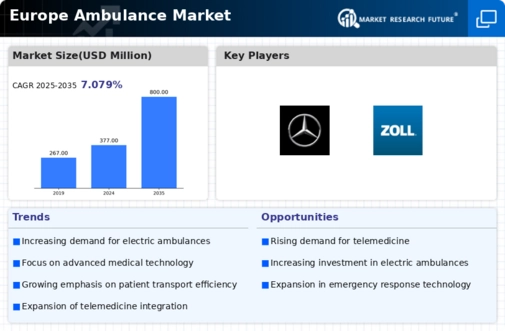The Europe Ambulance Market is characterized by a diverse range of players striving to maintain a competitive edge in this essential sector. With the growing emphasis on healthcare accessibility and emergency response effectiveness, companies in this market are innovating their offerings while also focusing on customer satisfaction and operational efficiency.
Amidst advancements in technology and increasing demands for improved emergency medical services, understanding the competitive landscape is crucial for businesses aiming to optimize their positioning and strategy in this vibrant market.
Various manufacturers are not only competing in terms of product offerings but also in pricing, service quality, and brand reputation, thereby making the market dynamic and multifaceted.
Mercedes-Benz has established a strong foothold in the European Ambulance Market, largely driven by its reputation for high-quality engineering and reliability. The company’s ambulances are equipped with advanced technology and safety features that enhance the efficiency and effectiveness of emergency medical services.
Its commitment to innovation is reflected in the continuous upgrades to its fleet, which is tailored to meet the diverse needs of different healthcare providers across Europe. Additionally, Mercedes-Benz offers customization options for ambulances, allowing healthcare organizations to tailor vehicles to their specific operational needs.
The brand benefits from an extensive service network across Europe, ensuring that support and maintenance are readily available. This accessibility strengthens its market presence and customer loyalty, positioning Mercedes-Benz as a leader in the ambulance segment within the continent.
KME Fire, another significant player in the Europe Ambulance Market, offers a range of specialized emergency response vehicles that include not only ambulances but also fire trucks and rescue vehicles. The company is known for its innovative approach to design and functionality, ensuring that its products meet rigorous safety and performance standards required for emergency services.
KME Fire's strength lies in its ability to cater to specific regional needs within Europe, offering customized solutions that align with local regulations and operational requirements. The company has also engaged in strategic mergers and acquisitions to enhance its product offerings and expand its market reach, solidifying its position within the competitive landscape.
Its commitment to quality and customer-centric solutions has enabled KME Fire to build strong relationships with healthcare providers and fire services, further enhancing its presence within the European market.













Leave a Comment